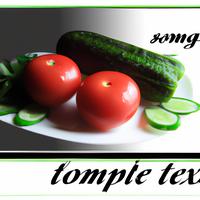
1 serving (100 grams) contains 15 calories, 0.7 grams of protein, 0.1 grams of fat, and 3.6 grams of carbohydrates.

Log this food in SnapCalorie

Nutrition Information
Calories |
35.7 | ||
|---|---|---|---|
% Daily Value* |
|||
| Total Fat | 0.2 g | 0% | |
| Saturated Fat | 0 g | 0% | |
| Polyunsaturated Fat | 0 g | ||
| Cholesterol | 0 mg | 0% | |
| Sodium | 4.8 mg | 0% | |
| Total Carbohydrates | 8.6 g | 3% | |
| Dietary Fiber | 1.2 g | 4% | |
| Sugars | 4.0 g | ||
| protein | 1.7 g | 3% | |
| Vitamin D | 0 mcg | 0% | |
| Calcium | 38.1 mg | 2% | |
| Iron | 0.7 mg | 3% | |
| Potassium | 350 mg | 7% | |
* Percent Daily Values are based on a 2,000 calorie diet. Your daily values may be higher or lower depending on your calorie needs.
Food Attributes
Source of Calories
About Cucumber and tomato
Cucumber and tomato are refreshing, nutrient-rich vegetables commonly featured in Mediterranean, Middle Eastern, and global cuisines. Cucumbers, primarily composed of water, are hydrating and low in calories, making them an excellent choice for weight management and hydration. They also provide small amounts of vitamins K and C and antioxidants. Tomatoes, on the other hand, are a rich source of vitamin C, potassium, and the antioxidant lycopene, which is linked to heart health and reduced risk of certain cancers. Together, they create a flavorful and nutritious pairing, often found in salads, sandwiches, and salsas. Low in fat and free of cholesterol, cucumber and tomato dishes are typically healthy, though adding heavy dressings or high-sodium seasoning may reduce their overall benefits. Their versatility and vibrant tastes make them a staple in many healthy eating plans.



